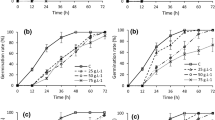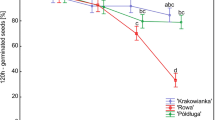Abstract
Prangos ferulacea is one of the widely used, nutritional and popular fodders in livestock industry. This species is also considered as an important option in rangeland restoration and management. In this study, the comparative phytotoxic activity of aqueous and hydroalcoholic extracts obtained from different organs (flower, shoot and leaf) of P. ferulacea on proline content, seed germination and seedling growth of Trifolium resupinatum has been investigated. According to the results, the hydroalcoholic extract of P. ferulaceae flower possesses the highest total phenolic and flavonoid content and the uppermost phytotoxic effect on T. resupinatum. The extracts significantly decreased seed germination and seedling growth of T. resupinatum and increased the proline content. Our findings indicate that hydroalcoholic extract induced a stronger oxidative stress in T. resupinatum. Finally, based on the results, aqueous allelochemicals that originated from P. ferulacea played a significant role in the successful propagation and development of T. resupinatum in rehabilitated pastures. According to our results, the phytotoxicity effect of the hydroalcoholic extract was significantly higher than that of the aqueous extract. Since in nature, the allelopathic interaction between plants is closer to the aqueous method, primary evaluations of rangeland restoration using this method is suggested.




Similar content being viewed by others
References
Abenavoli R, Cacco G, Sorgona A, Marabottini RA, Paolaccir M, Badinai M (2006) The inhibitory effects of coumarin on the germination of durum wheat seeds. J Chem Ecol 32:489–506
Ahmed J, Guvence A, Kucuboyaci N, Baldemir A, Coskun M (2011) Total phenolic contents and antioxidant activities of Prangos Lindl. (Umbelliferae) species growing in Konya province (Turkey). Turk J Biol 35:353–360
Azarfard F (2008) Effect of Prangos ferulacea replacement for alfalfa on growth performance and carcass characteristics of Lori lambs. Int J Agric Biol 10:224–226
Batish DR, Singh HP, Setia N, Kaur S, Kohli RK (2006) 2-Benzoxazolinone (BOA) induced oxidative stress, lipid peroxidation and changes in some antioxidant enzyme activities in mung bean (Phaseolus aureus). Plant Physiol Biochem 44:819–827
Chen ZH, Lin FP, Zhang DM (1999) Physio-ecological study on the seed germination and seeding growth in four legume tree species under elevated CO2 concentration. Chin J Plant Ecol 23:161–170
Correa LR, Soares GLC, Fett-Neto AG (2008) Allelopathic potential of Psychotoria leiocarpa, a dominant understorey species of subtropical forests. S Afr J Bot 74:583–590
Coskun B, Gulsen N, Umucalilar HD (2004) The nutritive value of Prangos ferulacea. Grass Forage Sci 59:15–19
Cruz-Ortega R, Ayala-Cordero G, Anaya AL (2002) Allelochemical stress produced by the aqueous leachate of Callicarpa acuminata: effects on roots of bean, maize and tomato. Physiol Plant 116:20–27
Eilami B (2008) Substitution of alfalfa hay with Prangos ferulacea in the fattening diet of gray shirazy sheep. Pajouhesh-Va-Sazandegi 79:52–57 (in Persian)
Gill SS, Toteja N (2010) Reactive oxygen species and antioxidant machinery in abiotic stress tolerance in crop plants. Plant Physiol Biochem 48:909–930
He H, Song QM, Wang YF, Yu SX (2014) Phytotoxic effects of volatile organic compounds in soil water taken from a Eucalyptus urophylla plantation. Plant Soil 307:203–211
Ibanez J, Martinez J, Schnabel S (2007) Desertification due to overgrazing in a dynamic commercial livestock-grass-Soil system. Ecol Model 205:277–288
Iranian Nomadic Organization (1992) In: Proceedings of development strategy of Iranian nomadic life. Ashayeri Publications, Iran
Jiang GB, Zeng RS (2006) Allelopathic potentials of volatiles from Artemisia lavandulaefolia DC. Prod Ecol Sci 25:106–108
Kaur S, Singh HP, Batish DR, Kohli RK (2012) Artemisia scoparia essential oil inhibited root growth involves reactive oxygen species (ROS)-mediated disruption of oxidative metabolism: in vivo ROS detection and alterations in antioxidant enzymes. Biochem Syst Ecol 44:390–399
Palmer MA, Ambrose RF, Poff NL (1997) Ecological theory and community restoration ecology. Restor Ecol 5:291–300
Razavi SM (2012) Chemical composition and some allelopathic aspects of essential oils of (Prangos ferulacea L.) Lindl at different stages of growth. J Agric Sci Technol 14:349–356
Rokhfirooz G, Ghorbani J, Shokri M, Jafarian Jelodar Z (2011) Effect of rangeland rehabilitation and restoration on composition and diversity of species seeds in the soil. Iran J Range Desert Res 18:322–335
Sadeghi S, Robati Z (2015) Response of Cichorium intybus L. to eight seed priming methods under osmotic stress conditions. Biocatal Agric Biotechnol 4:443–448
Taban A, Saharkhiz MJ (2015) Natural phytotoxic activity of water extracts and dried leaf powders of three Satureja species. Biocatal Agric Biotechnol 4:594–602
Tawaha K, Alali FQ, Gharaibeh M, Mohammad M, El-Elimat T (2007) Antioxidant activity and total phenolic content of selected Jordanian plant species. Food Chem 104:1372–1378
Tiffany L, Park S, Vivanco GM (2004) Biochemical and physiological mechanisms mediated by alleochemicals. Curr Opin Plant Biol 7:472–479
Wang JC, Wu Y, Wang Q, Peng YL, Par KW, Luo P, Wu N (2009) Allelopathic effects of Jatropha curcas on marigold (Tagetes erecta L.). Allelopathy J 24:123–130
Weston LA, Mathesius U (2013) Flavonoids: their structure, biosynthesis and role in the rhizosphere, including allelopathy. J Chem Ecol 39:283–297
Zhang RM, Zou ZJ, Gao PJ, Hou P, Wen GS, Gao Y (2012) Allelopathic effects of VOCs of Artemisia frigida Willd. on the regeneration of pasture grasses in Inner Mongolia. J Arid Environ 87:212–218
Zilic S, Serpen A, Akıllıoğlu G, Gökmen V, Vančetović J (2012) Phenolic compounds, carotenoids, anthocyanins, and antioxidant capacity of colored maize (Zea mays L.) kernels. Agric Food Chem 60:1224–1231
Acknowledgements
Funding was provided by the Shiraz University (Grant no. 93GRD1M1939).
Author information
Authors and Affiliations
Corresponding author
Additional information
Communicated by MJ Reigosa.
Rights and permissions
About this article
Cite this article
Sadeghi, H., Bazdar, M. Effects of Prangos ferulacea aqueous and hydroalcoholic extracts obtained from different organs on the regeneration of Trifolium resupinatum. Acta Physiol Plant 40, 50 (2018). https://doi.org/10.1007/s11738-018-2626-7
Received:
Revised:
Accepted:
Published:
DOI: https://doi.org/10.1007/s11738-018-2626-7




